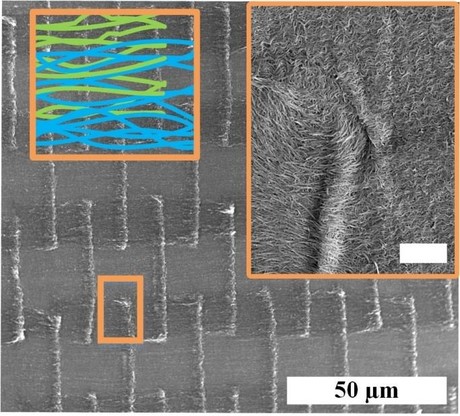Carbon nanotubes strengthen flexible electronics

Researchers from the University of Illinois at Urbana–Champaign have synthesised thin carbon nanotube (CNT) textiles that exhibit both high electrical conductivity and a level of toughness that is about 50 times higher than the copper films currently used in electronics.
Writing in the journal Advanced Engineering Materials, the researchers explained that flexible electronics require electrically conductive and mechanically reliable nanoscale thin films.
“However,” they said, “thin metal films have low fracture energy, which limits the performance of flexible devices.”
The researchers turned their attention to carbon nanotubes, which have been hailed as a wonder material for numerous nanotechnology applications. These tiny cylindrical structures made from wrapped graphene sheets have a diameter of just a few nanometres — yet a single carbon nanotube is stronger than steel and carbon fibres, more conductive than copper and lighter than aluminium.
Unfortunately, it has proven difficult to construct materials such as fabrics or films that demonstrate carbon nanotubes’ properties on centimetre or metre scales. This is because CNTs are tricky to assemble and weave together, since they are so small, and their geometry is very hard to control. But that didn’t stop the researchers from using CNTs to design and synthesise their own tough films.
Beginning with the catalyst deposited on a silicon oxide substrate, vertically aligned carbon nanotubes were synthesised via chemical vapour deposition in the form of parallel lines of 5 µm width, 10 μm length and 20–60 μm heights. As explained by lead author Yue Liang, “The staggered catalyst pattern is inspired by the brick and mortar design motif commonly seen in tough natural materials such as bone, nacre, the glass sea sponge and bamboo.
“Looking for ways to staple the CNTs together, we were inspired by the splicing process developed by ancient Egyptians 5000 years ago to make linen textiles,” Liang continued. “We tried several mechanical approaches, including microrolling and simple mechanical compression to simultaneously re-orient the nanotubes, then, finally, we used the self-driven capillary forces to staple the CNTs together.”
According to Assistant Professor Sameh Tawfick, who also worked on the paper, the CNT textile can be used in smart textiles, smart skins and flexible electronics, representing a tough and attractive material which can replace thin metal films to enhance device reliability.
“Aligned carbon nanotube sheets are suitable for a wide range of applications spanning the micro- to the macro-scales, including microelectromechanical systems (MEMS), supercapacitor electrodes, electrical cables, artificial muscles and multifunctional composites,” he said.
Organic transistor 'limitation' improves stability
Researchers have shown that a longstanding organic transistor design limitation actually improves...
OLED circular polarisation is now electrically switchable
Researchers have discovered a way to control left- or right-handed polarised light via charge...
Nanoscale pixels to advance augmented reality eyewear
Physicists have developed extremely small pixels that can be used in compact AR glasses, using...




